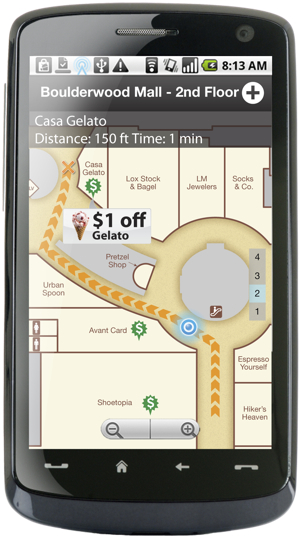Meet Philip Stanger, CEO of Wifarer, who wants you to always find your way in shopping malls and museums.

Philip Stanger is the CEO of Wifarer, an indoor positioning technology company. What happens when GPS goes indoors? A new form of business discovery. Wifarer just launched in the Royal British Columbia Museum. Fast Company chatted with Stanger about serendipity, the unevenness of museum docents, and how humans are giant bags of water.
FAST COMPANY: What is Wifarer?
PHILIP STANGER: What we’ve done is create an indoor positioning system. We take a venue’s pre-existing Wi-Fi, which creates radio frequency fingerprints, we capture these fingerprints, and from those we infer users’ locations.
So it’s like GPS, but indoors.
Exactly, it’s indoor GPS. GPS doesn’t work indoors, so another solution had to be found. Other solutions previously involved hardware, whether it be NFC, RFID, or Bluetooth, but the hardware solution for a lot of venues was really a non-starter.
What’s an example of a “venue”?
A venue is large, complex places like a hospital, shopping center, or airport. Any indoor environment large and complex enough where position can be relevant. What they do within it doesn’t matter: there’s great similarity between a museum and a hospital, for instance, when it comes to trying to engage users.
How many venues is Wifarer in now?
We’re in a couple dozen venues, the majority in the U.S., with a few in Canada and one in Spain. We’re scheduled to go into a large hospital. We’re in a few airports, and a few universities. In the next couple weeks we’ll be announcing a large and important stadium we’ve partnered with. We’re in a large convention center, one museum, with another museum coming shortly, and a few shopping centers.
GPS made it so we no longer have to pull over at gas stations for directions. Now will indoor positioning make it so we no longer have to interact with the people at information desks? Isn’t this another instance of technology cutting us off from people?
The impetus for the idea came from a museum experience I had. I was at the National Portrait Gallery in London, and I was following a tour guide--he was skimming over various works. Then I overheard another tour guide walking close by, and he was much more detailed and colorful in his language. It was a totally different experience of the venue. I thought, wouldn’t it be great to standardize that, so everyone can have that experience? Wouldn’t it be great if you could provide content that had multimedia components streaming that gave contextualized information, displayed in a dynamic fashion? With my experience, the human interaction I had wasn’t as satisfying as another one I could have had.
 How does the Wifarer app work? What sorts of content do you display?
How does the Wifarer app work? What sorts of content do you display?
As you’re walking around, you’ll see these content pop-ups. It could be a piece of video, or a coupon, or it could be ordinary text, defining the area a little bit more. As you walk around, these pop-ups expand dynamically. In our next phase, particularly with shopping centers, we’ll have a system that entices users into shops through discounts or loyalty points. Once they’ve interacted with the pop-up, the store has the ability to market to them.
We’ve been dubbing this “the discovery economy” here at Fast Company--the idea that apps can help enable you to find cool real-world businesses that you otherwise might have missed.
That’s the whole raison d’être for Wifarer: to enhance the experience of a venue through discovery, through finding out things you didn’t know. You can learn more about a store or a product in depth. “Oh, I don’t know about this couch. Where is it actually made, and why am I paying so much more for this special construction?” You can have someone contextualize that, and be able to sell the value of that product in away that might not be possible apart from having somebody standing right in front of it.
Google Maps, among others, have entered indoor positioning. How do you expect to compete?
We offer basically a private version of Google Maps for a venue. That way the venue is able to control content, monetization, and branding. What we find, particularly with shopping centers, is that they’ve spent hundreds of millions if not billions building chains, and they’re not keen on losing control of the monetization of the space. That’s where we come in. There’s pros and cons to all services, and we’ve tried to respond to the marketplace. As enamored as people were with Google, they were keen on keeping the monetization aspect for themselves, which opened up a bit of a window for us.
So how do you make money?
Service for a fee is the primary way. In other venues, we’re looking at transaction-based monetization. When we have a much larger footprint, we’ll look into advertising.
Why is indoor positioning finally taking off now?
The history of IPS goes back into the 90s, when DARPA spent hundreds of millions trying to figure it out. It’s taking off now because you have a prevalence of Wi-Fi everywhere, and you have smartphone technology with the processing power to calculate your position. Having said that, there’s still lots of challenges, one of the more boring facts being that Wi-Fi broadcasts at 2400 GHz, which happens to be the resonating frequency of water, and human beings are basically bags of water walking around, so the more people there are around, the more it resonates, and it’s harder to find their location. But all of these things, through various mathematical and probability techniques, can be resolved.
This interview has been condensed and edited.
For more from the Fast Talk interview series, click here. Know someone who'd make a good Fast Talk subject? Mention it to David Zax.
Follow Fast Company on Twitter.
[Image: Flickr user hmomoy]